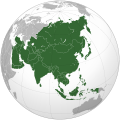Alternative scenarios
Paleogeologist Ronald Blakey has described the next 15 to 100 million years of tectonic development as fairly settled and predictable [2] but no supercontinent will form in that time frame. Beyond that, he cautions that the geologic record is full of unexpected shifts in tectonic activity that make further projections "very, very speculative". [2] In addition to Novopangaea, two other hypothetical supercontinents—"Amasia" and Christopher Scotese's "Pangaea Ultima"—were illustrated in an October 2007 New Scientist article. [3] Another supercontinent prediction, Aurica, has been proposed in more recent times, suggesting the closures of both the Atlantic and Pacific Oceans.
Research by Masaki Yoshida and Madhava Santosh in August 2011 suggests that due to the presence of relatively hot large low-shear-velocity provinces below Africa and the Pacific preventing convergent plate tectonics, South America might not be able to cross the Pacific as suggested by the Novopangaea model, rather staying close to its current position relative to North America, and Antarctica may not be able to leave the South Pole as suggested. Therefore, they suggest that while Eurasia, Africa, Australia, and North America may merge as suggested, South America and Antarctica will remain separate from the resultant supercontinent by an only partially closed Pacific Ocean. [4] [5]
This page is based on this
Wikipedia article Text is available under the
CC BY-SA 4.0 license; additional terms may apply.
Images, videos and audio are available under their respective licenses.











